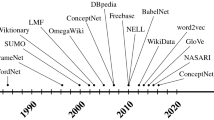Abstract
This paper addresses the problem of building conceptual resources for multilingual applications. We describe new techniques for large-scale construction of a Chinese-English lexicon for verbs, using thematic-role information to create links between Chinese and English conceptual information. We then present an approach to compensating for gaps in the existing resources. The resulting lexicon is used for multilingual applications such as machine translation and cross-language information retrieval.
Preview
Unable to display preview. Download preview PDF.
Similar content being viewed by others
References
Dang, H.T. Kipper, K., Palmer, M., Rosenzweig, J.: Investigating Regular Sense Extensions Based on Intersective Levin. In: ACL/COLING 98, Proceedings of the 36th Annual Meeting of the Association for Computational Linguistics.(1998) 293–299
Dorr, B.J.: Large-Scale Acquisition of LCS-Based Lexicons for Foreign Language Tutoring. Proceedings of the ACL Fifth Conference on Applied Natural Language Processing (ANLP). (1997) 139–146
Dorr, B.J., Habash, N., Traum, D.: A Thematic Hierarchy for Efficient Generation from Lexical-Conceptal Structure. In: Proceedings of the Third Conference of the Association for Machine Translation in the Americas, AMTA-98, in: Lecture Notes in Artificial Intelligence, 1529. (1998) 333–343
Dorr, B.J., Jones, D.: Acquisition of semantic lexicons: Using word sense disambiguation to improve precision. In: Viegas, E.(ed.): Breadth and Depth of Semantic Lexicons. (1999)
Dorr, B.J., Katsova, M.: Lexical Selection for Cross-Language Applications: Combining LCS with WordNet. In: Proceedings of the Third Conference of the Association for Machine Translation in the Americas, AMTA-98, in Lecture Notes in Artificial Intelligence, 1529. (1998) 438–447
Dorr, B.J., Levow, G.-A., Lin, D., Thomas, S.: Chinese-English Semantic Resource Construction. In: Proceedings of the 2nd International Conference on Language Resources and Evaluation (LREC2000). (2000)
Jones, D., Berwick, R., Cho, F., Khan, Z., Kohl, K., Nomura, N., Radhakrish-nan, A., Sauerland, U., Ulicny, B.: Verb Classes and Alternations in Bangla, German, English, and Korean. Technical report, Massachusetts Institute of Technology (1994)
Langkilde, I., Knight, K.: Generating Word Lattices from Abstract Meaning Representation. Technical report, Information Science Institute, University of Southern California (1998)
Langkilde, I., Knight, K.: Generation that Exploits Corpus-Based Statistical Knowledge. In: Proceedings of COLING-ACL’ 98. (1998) 704–710
Langkilde, I., Knight, K.: The Practical Value of N-Grams in Generation. In: International Natural Language Generation Workshop. (1998)
Levin, B.: English Verb Classes and Alternations: A Preliminary Investigation. University of Chicago Press, Chicago, IL (1993)
Levow, G.-A., Dorr, B., Katsova, M.: Construction of Chinese-English Semantic Hierarchy for Cross-Language Retrieval. In: Proceedings of the Workshop on English-Chinese Cross Language Information Retrieval, International Conference on Chinese Language Computing. (2000)
Lin, D.: Dependency-based Evaluation of MINIPAR. In: Proceedings of the Workshop on the Evaluation of Parsing Systems, First International Conference on Language Resources and Evaluation. (1998)
Miller, G.A., Fellbaum, C: Semantic Networks of English. In: Levin, B., Pinker, S. (eds): Lexical and Conceptual Semantics, Cognition Special Issue. Elsevier Science Publishers B.V., Amsterdam, The Netherlands (1991) 197–229
Nomura, N., Jones, D.A., Berwick, R.C.: An architecture for a universal lexicon: A case study on shared syntactic information in Japanese, Hindi, Ben Gali, Greek, and English. In: Proceedings of COLING-94. (1994) 243–249
Olsen, M.B., Dorr, B.J., Thomas, S.C.: Enhancing Automatic Acquisition of Thematic Structure in a Large-Scale Lexicon for Mandarin Chinese. In: Proceedings of the Third Conference of the Association for Machine Translation in the Americas, AMTA-98, in: Lecture Notes in Artificial Intelligence, 1529. (1998) 41–50
Palmer, M., Rosenzweig, J.: Capturing motion verb generalizations with synchronous tags. In: Proceedings of the Second Conference of the Association for Machine Translation in the Americas. (1996)
Palmer, M., Wu, Z.: Verb Semantics for English-Chinese Translation. Machine Translation.10(1-2) (1995) 59–92
Procter, P.: Longman Dictionary of Contemporary English. Longman, London (1978)
Resnik, P.: Using information content to evaluate semantic similarity in a taxonomy. In: Proceedings of IJCAI-95 (1995) 448–453
Saint-Dizier, P.: Semantic Verb Classes Based on ‘Alternations’ and on WordNet-like Semantic Criteria: A Powerful Convergence. In: Proceedings of the Workshop on Predicative Forms in Natural Language and Lexical Knowledge Bases. (1996) 62–70
Weinberg, A., Garman, J., Martin, J., Merlo, P.: Principle-Based Parser for Foreign Language Training in German and Arabic. In: Holland, M., Kaplan, J., Sams, M. (eds.): Intelligent Language Tutors: Theory Shaping Technology. Lawrence Erl-baum Associates, Hillsdale, NJ (1995) 23–44
Dong, Z. Enlightment and Challenge of Machine Translation. Shanghai Journal of Translators for Science and Technology. 1 (1998) 9–15
Dong, Z.: Knowledge Description: What, How and Who? In: Proceedings of International Symposium on Electronic Dictionary. (1988) 18
Dong, Z.: MT Research in China. In: Proceedings of International Conference on New Directions in Machine Translation (1988) 85–91
Author information
Authors and Affiliations
Editor information
Editors and Affiliations
Rights and permissions
Copyright information
© 2000 Springer-Verlag Berlin Heidelberg
About this paper
Cite this paper
Dorr, B.J., Levow, GA., Lin, D. (2000). Building a Chinese-English Mapping Between Verb Concepts for Multilingual Applications. In: White, J.S. (eds) Envisioning Machine Translation in the Information Future. AMTA 2000. Lecture Notes in Computer Science(), vol 1934. Springer, Berlin, Heidelberg. https://doi.org/10.1007/3-540-39965-8_1
Download citation
DOI: https://doi.org/10.1007/3-540-39965-8_1
Published:
Publisher Name: Springer, Berlin, Heidelberg
Print ISBN: 978-3-540-41117-8
Online ISBN: 978-3-540-39965-0
eBook Packages: Springer Book Archive




